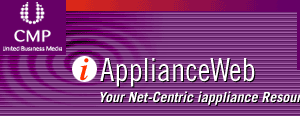



 |
 |
|
|
 |

|
||
|
|
|
|
|||

|
Netcentric View: Mobile connected iAppliances and the Net-Centric View
By Bernard Cole
|
|||||||||||
 |
Second, it is not so much a collision between computing and communications. Rather it's a collision between connectionless packet-based networking, which grew out of the need of large organizations to link the widely distributed desktop systems, and the connection-based environment of the public switched telephone, in which connections are made and information exchanged between specific senders and receivers.
The result of this collision is a new net-centric communications environment in which connectionless packet-based methodologies will dominate all communications, even voice. In this environment, every message, whether voice, images, sounds, video or computer data is digitized and broken up into packets, each of which is transmitted independently and recombined when it finds a recipient with the appropriate settings.
As is true of net-centric computing, net-centric communications is still emerging, with new devices, protocols and even OEM channels still to be identified. Very little of the traditional data communications or telecommunications technology will remain. It is being transformed almost entirely by the packet-based creation of the computer industry. More than just being digitized, normal telephone conversations will be transmitted in new voice-over-Internet-protocol (VoIP) software and hardware managed by a new breed of server/router/switch hybrids.
Net-centric communications have transformed, and will continue to transform, how we connect to each other as well as the tools, software and hardware that result.
Initially I thought that as net-centricity expanded to include both computing and communications, the problem of naming the specific devices would get even more complicated. In the first of several columns I went through at least a dozen or so names for the devices in all segments that sought to define their essence. Some were too specific, some too broad, and some entirely missed the point.
Now, I think I have found the term that captures the essence of things: the "Internet appliance," or " iAppliance," if you will.
According to dictionaries the word "appliance" refers to "any instrument, apparatus, or device designed for a particular purpose or use." In the kitchen, there are a variety of appliances, usually electrical in nature, used to accomplish particular tasks ranging from large general purpose systems such as refrigerators, stoves and dishwashers to extremely small dedicated tools such as can openers, toasters and electric grills. In addition to their specific functions, all share a common characteristic: to allow us to navigate around and use the kitchen environment efficiently and easily. In the office there are similar appliances, as there are in almost any specialized area of endeavor.
While each tool has a specific name, they all share the name "appliance" because they all share at least one common purpose, to allow us to navigate around and accomplish tasks, in specific environments.
In the net-centric computing and communications environment, the appellation of "iAppliance" is a good generic description of all the various hardware and software mechanisms we need to simplify moving about the World Wide Web and the Internet and using them.
An iAppliance, by this definition, can be anything from a Web enabled information device or cell phone to a desktop computer that accesses the network. It can be, and has been, used to describe a variety of specialized server and router devices and systems as well.
In my definition of iAppliance, I don't differentiate between hardware and software for a number of reasons. First, in an information-based environment, the tools we need to do our job are both hardware and software. Second, as markets evolve and mature, what is first done in software often moves into hardware. What continues and is most important is the function and the algorithm by which this is achieved.
What impact does this reconfiguration of computing and communications have on the existing market segments, the engineers who build the systems and the companies who are trying to establish - or maintain -- a presence that the current turmoil has upset?
A developer or a company developing hardware and software building blocks in a segment that was particularly well defined previously, such as embedded, desktop, or server computing will find that some of the tools are the same, but the challenges are greater, requiring more attention to issues such as security, reliability, interoperability, and networkability. New tools and methodologies will emerge, some extensions of previous ones and some entirely defined by the new computing and communicating environment.
In many cases, the situation is much the same as the transition in the late '70s and early '80s. Then the dominant mind set in the emerging microprocessor-based market was totally focused in replacing electromechanical controls with microcontrollers and microcomputers. As a new paradigm emerged based on desktop computing, the tools, operating systems, processors, and infrastructure support came from the existing solutions in the embedded, mini, and mainframe computing worlds, adapted to fit the new requirements and complemented by new tools and building blocks appropriate to the new model.
That is what I see here as we shift to net-centric computing and a new platform: the iAppliance. Much will be the same, but much is changing.
Having defined the new environment and pinned down as best I can the essential nature of the software and hardware devices that are emerging, what I will continue to do here is watch how net-centric communications and computing is changing, and how that affects the devices and vice versa.
For that I will continue to need your help in the dialog I hope to maintain in this column. Talk to me, tell me where I am wrong, what I have missed, what I got right, and what you think.
Is my perception of net-centric computing and communications a correct one? Do you agree with the way I have defined and named the software and hardware devices that are emerging?
Reader feedback
I think 'iAppliiance' is a great name for the new devices.
I think you covered well in appellation of the new term. However, I have couples of questions such as how the iAppliances could effect human life or What customers really want in the new environment and what functions will be important?
I am enjoying reading all your columns and looking forward to seeing your next column.
Heeyong Park
Researcher
Samsung Electronics
Bernard Cole is site leader and editor of iApplianceweb and an independent high technology editorial services consultant. He welcomes your feedback. Call him at or send an email to .
For more information about topics, issues and technologies mentioned in this story go to the flashing icon in the upper left corner on this page or go to the iAppliance Web Views page and call up the associatively-linked Java/XML-based Web map of the iApplianceWeb site.
Enter the appropriate key word, product or company name to list instantly every news and product story, product review and product database entry relating to the topic since the beginning of the 2002.
![]()

